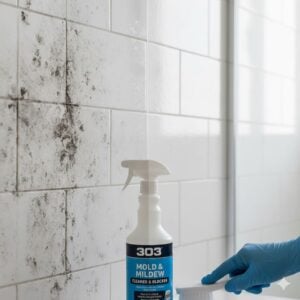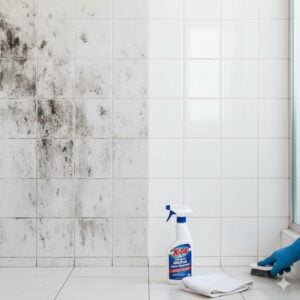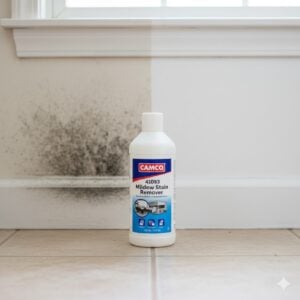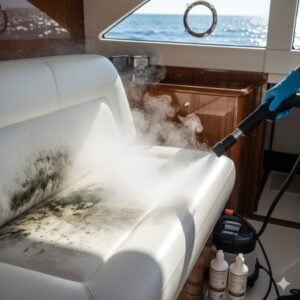Mildew is a type of fungus that grows in warm, damp, and poorly ventilated environments. It often appears as a thin, powdery, or fluffy layer on surfaces such as walls, ceilings, fabrics, and even plants. While many people use the term interchangeably with mold, mildew has specific characteristics that distinguish it in both appearance and behavior. Understanding what mildew is, why it grows, and how to prevent it is essential for maintaining a healthy indoor environment—especially in humid climates like the UAE.
Table of Contents
ToggleWhat Is Mildew?
Mildew refers to certain species of fungi that thrive on organic materials when moisture and warmth are present. It typically grows flat on the surface rather than penetrating deeply like mold. Mildew is lighter in color, usually appearing white, gray, or yellow, and has a soft or fluffy texture. In contrast, mold tends to be darker—green, brown, or black—and can dig deeper into materials, causing structural damage.
When mildew first forms, it often looks like small spots or patches, but if left untreated, these patches can spread rapidly. It emits a musty, stale odor similar to wet fabric or damp basements, which is a common sign of fungal growth indoors.
The Science Behind Mildew Growth
Like all fungi, mildew reproduces through spores—tiny particles that float through the air. These spores settle on moist surfaces and begin to grow when conditions are favorable. The ideal environment for mildew includes:
- High humidity – typically above 60% relative humidity
- Moderate temperatures – between 24°C to 35°C
- Low air circulation – poor ventilation traps moisture
- Organic surfaces – materials like fabric, paper, leather, and drywall
In homes, mildew often develops in bathrooms, kitchens, basements, and around windows. In the UAE, air conditioners and high indoor humidity can make walls, carpets, and furniture especially prone to mildew if not cleaned regularly.
Mildew vs. Mold: Understanding the Difference
Although mildew and mold are related, they differ in both appearance and potential impact:
| Characteristic | Mildew | Mold |
|---|---|---|
| Color | White, gray, or yellow | Green, black, or brown |
| Texture | Flat and powdery | Thick, fuzzy, or slimy |
| Depth of Growth | Surface level | Penetrates materials deeply |
| Odor | Musty but mild | Strong, unpleasant, earthy |
| Damage | Discoloration, minor odor | Structural decay, health hazards |
Mildew is generally easier to remove than mold, but if ignored, it can still trigger allergies, damage fabrics, and lead to unpleasant smells that persist in living spaces.
Types of Mildew
There are two main types of mildew: powdery mildew and downy mildew.
- Powdery mildew: Appears white or gray, resembling flour dust. It’s common on fabrics, papers, and even plant leaves. This form thrives in warm, dry climates with poor ventilation.
- Downy mildew: Appears yellow or brown and feels damp or slimy. It grows in cooler, wetter conditions and is commonly found on organic materials like leather or paper.
In indoor spaces, powdery mildew is more prevalent due to the combination of air conditioning and humidity trapped behind furniture or curtains.
Causes of Mildew Growth Indoors
Several factors can contribute to mildew development inside buildings:
- Humidity and condensation: Bathrooms, laundry areas, and kitchens often experience constant moisture that promotes fungal growth.
- Leaks: Even small plumbing or roof leaks can create hidden moisture pockets behind walls and floors.
- Poor ventilation: Lack of air movement allows moisture to linger, especially in closed-off rooms or apartments.
- Dirty surfaces: Dust and grime serve as a food source for mildew spores.
- Improper drying: Wet carpets, curtains, or laundry left indoors can trigger mildew within hours.
Health Effects of Mildew Exposure
While mildew is less toxic than black mold, prolonged exposure can still affect health—particularly for those with allergies or respiratory issues. Common symptoms include:
- Runny or stuffy nose
- Coughing and sneezing
- Eye irritation or redness
- Skin rash or itching
- Headaches or fatigue due to poor air quality
People with asthma, children, or the elderly are especially sensitive to fungal spores. Inhaling these spores over time can worsen existing respiratory conditions.
How to Identify Mildew in Your Home
You can spot mildew early by watching for the following signs:
- Discolored spots — usually white, gray, or light yellow on walls or fabric
- Musty odor — especially in closed, humid spaces
- Surface texture — powdery or fuzzy to the touch
- Recurring stains — that return even after wiping with regular cleaner
To confirm mildew, apply a small amount of household bleach on the area. If the discoloration fades after a few minutes, it’s likely mildew. If it stays dark or spreads, it’s mold.
DIY Mildew Removal Methods
If caught early, mildew can often be removed safely using household products. Here’s how:
- Vinegar solution: Mix equal parts white vinegar and water. Spray the solution, let it sit for 10 minutes, then wipe clean.
- Baking soda: Sprinkle baking soda on affected areas to neutralize odor and absorb moisture. Wipe or vacuum afterward.
- Lemon juice: Acts as a mild natural bleach for fabrics and tiles.
- Hydrogen peroxide: For stubborn mildew, apply 3% hydrogen peroxide directly, wait 15 minutes, and rinse.
Always wear gloves and ensure proper ventilation while cleaning. However, DIY cleaning may not be sufficient for larger infestations or porous materials like drywall, carpet, or wood.
Risks of DIY Mildew Removal
DIY methods can control minor mildew but may spread spores if done incorrectly. Risks include:
- Incomplete removal — visible mildew may disappear, but spores remain active underneath.
- Overuse of water — causes deeper moisture penetration and secondary growth.
- Using harsh chemicals — bleach or ammonia can discolor surfaces or harm health.
- Missed contamination — hidden areas behind walls or under floors may continue spreading unnoticed.
DIY removal is suitable only for small, surface-level mildew patches. Larger or recurring issues should be handled by certified professionals.
Professional Mildew Cleaning and Treatment
Professional mildew cleaning involves specialized tools that eliminate fungi at the root. Companies like Bio-On UAE use steam-based disinfection and industrial-grade air filtration to kill spores and neutralize odors safely. The process typically includes:
- Inspection: Identifying mildew type and source of moisture
- Surface cleaning: Removing visible mildew and residue
- Deep sanitization: Steam treatment or antimicrobial sprays
- Drying and dehumidification: Preventing regrowth by controlling humidity
Unlike DIY cleaning, this process ensures long-term results and improved air quality. Bio-On UAE also checks for mold growth, which often accompanies mildew in humid interiors.
Estimated Price of Professional Mildew Removal in UAE
Professional mildew treatment costs depend on area size and severity:
- Small surface (bathroom corner or window sill): AED 200–300
- Medium area (1–3 sq.m.): AED 400–600
- Large wall or ceiling sections: AED 700–1000
- Severe infestations with odor removal: from AED 1000+
Bio-On UAE provides free inspection for larger affected areas. Prices are transparent, and clients are informed before any treatment begins.
Preventing Mildew in Homes and Buildings
Prevention is always better than removal. To stop mildew before it starts:
- Keep humidity below 50% using a dehumidifier or air conditioner
- Open windows regularly to improve airflow
- Fix leaks and condensation around windows or pipes
- Clean and dry spills immediately
- Use mildew-resistant paint in bathrooms and kitchens
Regular cleaning with mild vinegar or disinfectant can also discourage mildew spores from taking hold.
Why Professional Help Is Better Than DIY
While simple home remedies can handle mild mildew, they rarely address the root cause — moisture control. Bio-On UAE combines cleaning expertise with mold and odor remediation, offering long-term solutions rather than temporary fixes. Professional intervention ensures:
- Complete spore removal without surface damage
- Safe disinfection for families and pets
- Advanced drying to prevent regrowth
- Healthier air quality and improved comfort
Conclusion
Mildew may seem like a small nuisance, but it’s an early warning sign of moisture imbalance. Left unchecked, it can lead to unpleasant smells, allergic reactions, and potential mold development. While DIY solutions may work on minor spots, professional mildew removal ensures a lasting, hygienic fix. Bio-On UAE provides comprehensive mildew inspection, cleaning, and treatment services across the UAE — using eco-safe methods that restore both freshness and safety to your living spaces. Don’t ignore those white patches on your walls; act early and protect your home before the problem spreads.













